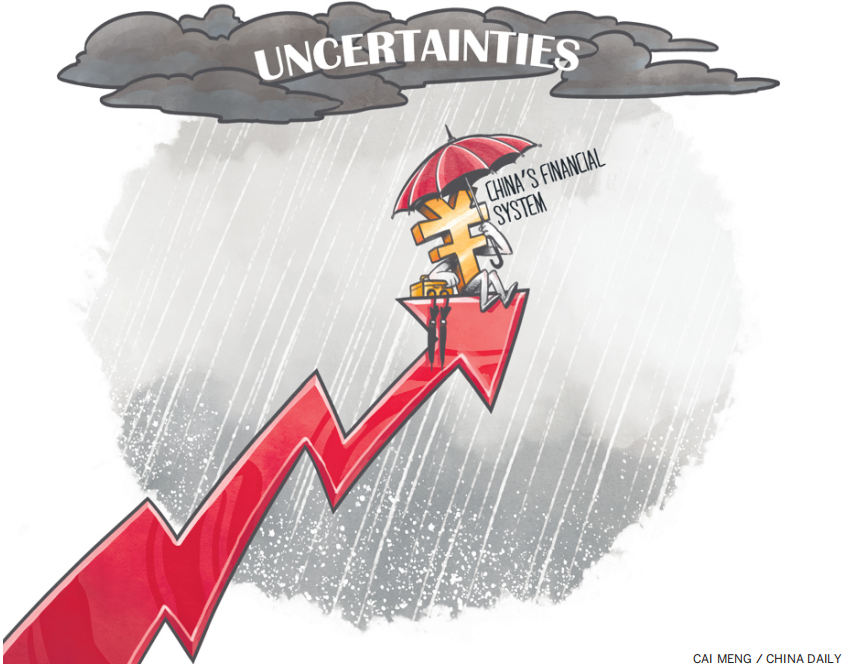Central bank's role evolves as economic structure is optimized


Editor's Note: The comments below are based on edited extracts from an article published in a guidance book on the CPC Central Committee's proposals for the formulation of the 14th Five-Year Plan (2021-25) for National Economic and Social Development and the Long-Range Objectives Through the Year 2035.
As China is shifting into a high-quality development phase and optimizing the economic structure, modern central banking is expected to be a crucial pillar that supports the transformation of the growth model and prevents inflation or deflation as well as systemic financial risks. Such a role played by the central bank can ensure the smooth modernization progress in China and safeguard national security.
Looking back into the development history of central banks globally, it is clear the major objective of central banks has been to finance the government. Over the years, central banks' mandatory functions shifted to maintaining the stability of currency value by adjusting currency and interest rates.
In the 1970s, major central banks across the globe began to lay emphasis on achieving sufficient employment. After the Global Financial Crisis in 2008, monetary authorities paid attention to financial stability, international coordination and cooperation.
In China, the People's Bank of China stopped providing financial services to corporates and individuals since 1984, and concentrated on performing the functions of the central bank.
The primary target was sustaining a stable currency value, in order to spur economic growth. The PBOC also focused on goals of financial stability and international balance of payments. In recent years, its stress has been on achieving a decent level of employment.
Against a background of unprecedented changes this century, in order to cope with the evolution of the central banking regime globally, China should accelerate the construction of a regime of modern central banking based on domestic conditions, after analyzing and learning from other central banks' successful experiences.
The framework of modern central banking is characterized by modern monetary policy, financial infrastructure, financial services, systemic risk prevention, international financial coordination, and good governance.
The goal of building a modern central banking regime is to achieve currency value stability, sufficient employment, financial stability and an equilibrium of international balance of payments. This also requires control of the total money supply, provision of high-quality financial infrastructure services, prevention of systemic financial risks, control of external spillover effects, promotion of fair and reasonable international financial governance.
In order to achieve the goal of currency value stability, the central bank needs to regulate the monetary creation of the banking system in a market-oriented manner. The premise is that the central bank can maintain a healthy and sustainable balance sheet.
Therefore, it is necessary for the central bank to implement an independent financial budget management system, to prevent the monetization of fiscal deficits, and build a "firewall" between the two "pockets" of the Ministry of Finance and the central bank.
At the same time, it is necessary to prevent the balance sheet of the central bank from bearing the credit risk of enterprises, which could ultimately affect the credibility of the renminbi.
Some key measures of building a regime of modern central banking would be the following:
First, build a systemic financial risk prevention and control system.
We have accumulated experiences in the battle of preventing and resolving major risks, and formed several effective risk disposal models. However, problems related to moral hazard in financial supervision and risk management are still prominent. The mechanisms of market discipline, bankruptcy deterrence and punishment have not yet been established.
Meanwhile, local governments and financial institutions have forced the central government and the central bank to undertake the high costs of bailout programs, on the ground of ensuring social stability.
As "the lender of last resort" in the financial system, the central bank has to fulfill the responsibility of preventing and controlling systemic financial risks.
From the perspective of prevention, the first priority is to improve the macro prudential management system to deal with the pro-cyclical behavior of financial institutions and the cross-institutional and cross-market contagion of financial risks.
The second challenge is to improve the basic system of prudential supervision and strengthen the coordination mechanism of financial supervision, so as to ensure that there is no blank in micro prudential supervision.
The third task is to guide behavioral supervision to protect the legitimate rights and interests of financial consumers.
The country should also clarify the responsibilities of shareholders, creditors, local governments and financial supervision departments. Investigations and punishments are needed for financial institutions, regulatory authorities and local governments that are responsible for major financial risks, so as to effectively prevent the risk of moral hazard.
Second, improve the governance mechanism of international financial coordination and cooperation. The large scale of China's economy can lead to strong spillover effects. The renminbi will gradually become a market-oriented international currency.
Thus the construction of a modern central banking regime requires promotion of the reform of the international monetary system and financial supervision mechanism.
China should actively participate in the construction of a global financial safety net. For its part, the PBOC will improve the renminbi exchange rate regime and promote the two-way opening up of the financial sector.
The writer is Yi Gang, governor of the People's Bank of China, the central bank.
- Platform to safeguard cybersecurity in China's financial sector takes shape
- In a year like no other, Chinese economy emerges stronger from unprecedented virus test
- Virtual red packets worth 20m digital yuan put into use in East China
- Green financing policy tools to be enriched: Central bank
- Fiscal support to lift China's growth efforts





































